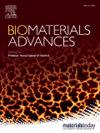改进耳廓重建:用PCL和TPU材料FDM 3D打印的作用。
IF 5.5
2区 医学
Q2 MATERIALS SCIENCE, BIOMATERIALS
Materials Science & Engineering C-Materials for Biological Applications
Pub Date : 2025-01-07
DOI:10.1016/j.bioadv.2025.214175
引用次数: 0
摘要
小耳畸形和外伤是造成外耳畸形的主要原因之一。耳廓重建的临床技术虽有不同,但都存在一定的缺陷。这项工作的重点是开发一种创新的3D多孔支架,通过熔融沉积建模(FDM)打印,并基于患者健康对侧耳朵的激光扫描图像。支架分别使用聚己内酯(PCL)和热塑性聚醚聚氨酯(TPU)来模拟软骨和脂肪组织的组成。优化打印参数后,将激光扫描得到的三维表面作为输出进行加工、切片,并将其作为打印层状结构的输入。微CT研究证实其结构均匀,孔隙连通良好。通过力学压缩和扭转试验验证了三维PCL/TPU结构的力学性能。三维结构显示出与耳廓软骨和脂肪部分相当的弹性模量。扭转试验表明,TPU和PCL印刷层之间没有分离的结构是适当的。体外细胞活力试验证实两种材料均无细胞毒性。PCL/TPU分层支架再现了患者健康对侧耳的解剖结构,代表了柔韧性和强度之间的良好折衷。这一点,连同其他经评估的特性,使这种支架成为外耳重建的有效选择。本文章由计算机程序翻译,如有差异,请以英文原文为准。
Toward improved auricle reconstruction: The role of FDM 3D printing with PCL and TPU materials
Microtia, along with trauma, represents one of the main causes of external ear malformation. Different clinical techniques were developed for the reconstruction of the auricle, but they all have some drawbacks. This work is focused on the development of an innovative 3D porous scaffold, printed by Fused Deposition Modelling (FDM) and based on laser-scanned images of the healthy contralateral ear of the patient. The scaffold was printed using polycaprolactone (PCL) and thermoplastic polyether urethane (TPU) to mimic the components of the cartilage and adipose tissue, respectively. After the optimization of the printing parameters, the 3D surface obtained as an output of the laser scan was elaborated, sliced and used as input for printing the layered structure. Micro CT investigation confirmed the structure homogeneity and good pore interconnection. Mechanical compression and torsion tests were performed to verify that the mechanical properties of the 3D PCL/TPU structure were adequate. The 3D structure exhibited elastic moduluses comparable to those of the cartilaginous and adipose parts of the auricle. The torsion tests showed the adequacy of the structure without detachment between TPU and PCL printed layers. In vitro cell viability tests confirmed the absence of cytotoxicity in both materials. The PCL/TPU layered scaffold reproduced the anatomy of the patient's healthy contralateral ear, representing a good compromise between flexibility and strength. This, along with the other assessed properties, makes this scaffold a valid alternative for the reconstruction of the external ear.
求助全文
通过发布文献求助,成功后即可免费获取论文全文。
去求助
来源期刊
CiteScore
17.80
自引率
0.00%
发文量
501
审稿时长
27 days
期刊介绍:
Biomaterials Advances, previously known as Materials Science and Engineering: C-Materials for Biological Applications (P-ISSN: 0928-4931, E-ISSN: 1873-0191). Includes topics at the interface of the biomedical sciences and materials engineering. These topics include:
• Bioinspired and biomimetic materials for medical applications
• Materials of biological origin for medical applications
• Materials for "active" medical applications
• Self-assembling and self-healing materials for medical applications
• "Smart" (i.e., stimulus-response) materials for medical applications
• Ceramic, metallic, polymeric, and composite materials for medical applications
• Materials for in vivo sensing
• Materials for in vivo imaging
• Materials for delivery of pharmacologic agents and vaccines
• Novel approaches for characterizing and modeling materials for medical applications
Manuscripts on biological topics without a materials science component, or manuscripts on materials science without biological applications, will not be considered for publication in Materials Science and Engineering C. New submissions are first assessed for language, scope and originality (plagiarism check) and can be desk rejected before review if they need English language improvements, are out of scope or present excessive duplication with published sources.
Biomaterials Advances sits within Elsevier''s biomaterials science portfolio alongside Biomaterials, Materials Today Bio and Biomaterials and Biosystems. As part of the broader Materials Today family, Biomaterials Advances offers authors rigorous peer review, rapid decisions, and high visibility. We look forward to receiving your submissions!

 求助内容:
求助内容: 应助结果提醒方式:
应助结果提醒方式:


